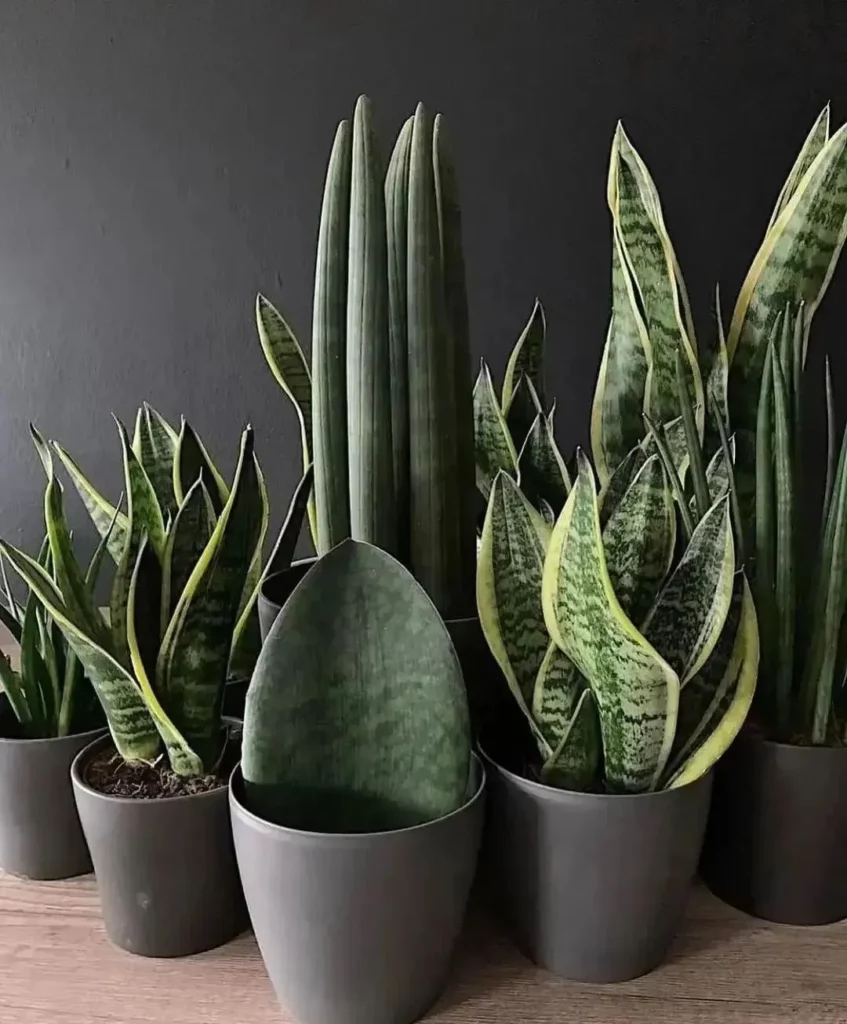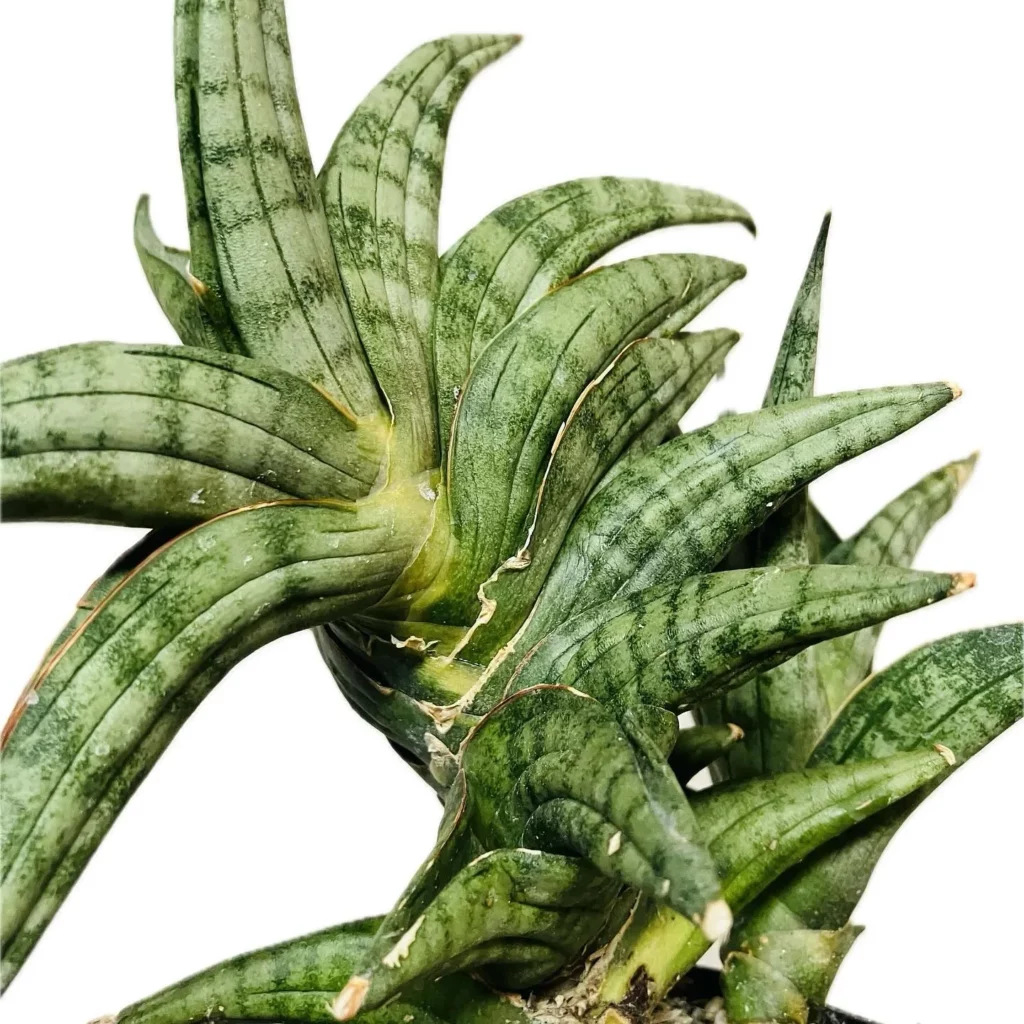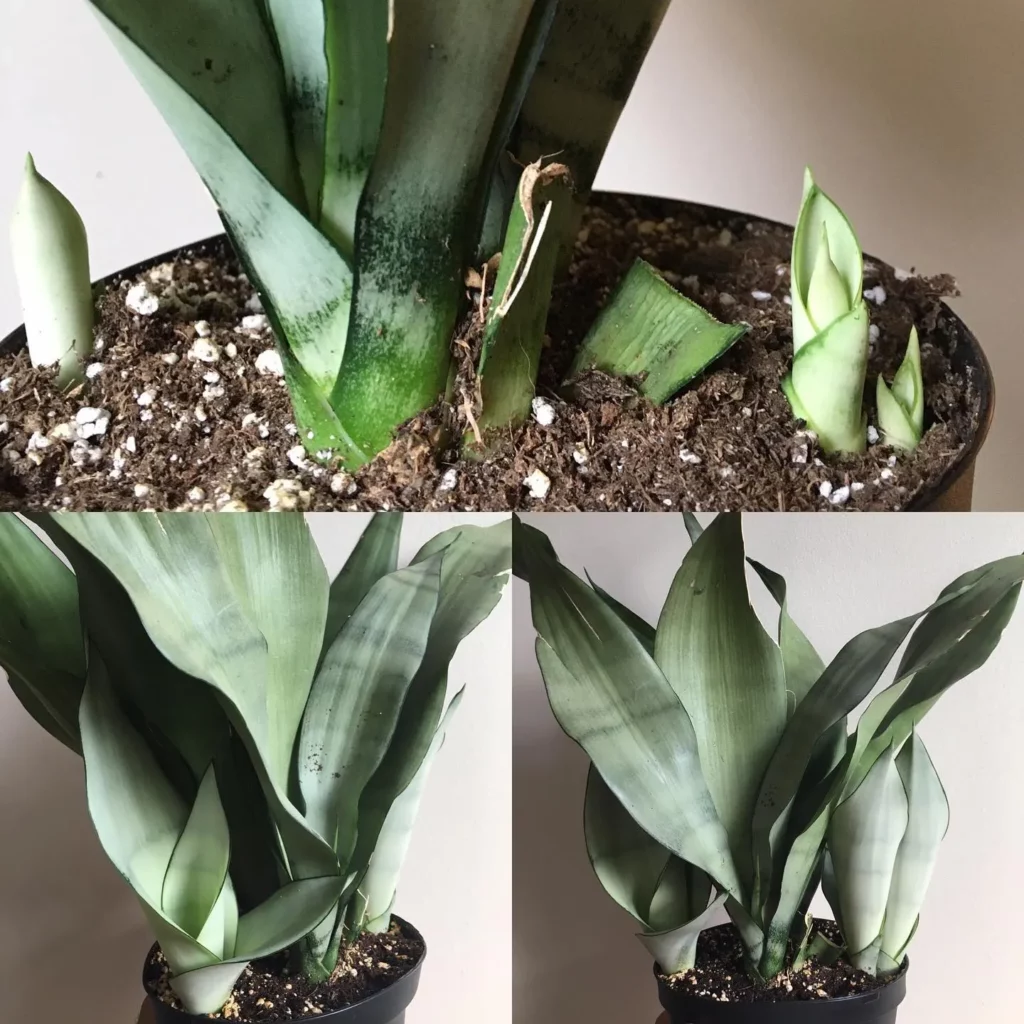To repot a snake plant, gently remove it from the current pot, trim any damaged roots, and replant it in a larger pot with well-draining soil and adequate drainage holes.
Repotting a snake plant is a simple task that even beginners can tackle with ease. Snake plants are known for their hardiness and forgiving nature, making them an ideal choice for indoor gardening. By repotting your snake plant, you can ensure its continued growth and health, allowing it to thrive in your living space. In this article, we will provide you with a step-by-step guide on how to repot a snake plant, including when to do it, what materials you’ll need, and the best practices for a successful repotting process.
Signs It’s Time to Repot a Snake Plant

If you want your snake plant to thrive and stay healthy, it’s essential to be aware of the signs that indicate it’s time to repot. Here are the key signs to look out for:
- The plastic pot is splitting or cracking: Over time, plastic pots can deteriorate and become damaged, compromising the integrity of the pot and the health of the plant.
- The plant fills the entire pot: When your snake plant starts to outgrow its current pot, its roots can become cramped and overcrowded, impeding its growth.
- The plant falls over repeatedly: If your snake plant keeps toppling over, even after you’ve adjusted its position, it could be a sign that it needs a larger pot for better stability.
- Water drains too quickly: If the water you pour into the pot drains out almost immediately, it may indicate that the potting soil is no longer able to retain enough moisture for the plant.
- Roots growing through the drainage holes: When you notice roots growing out of the drainage holes, it shows that the plant has become root-bound and needs more space to grow.
- The emergence of several new pups: Snake plants produce offshoots called pups, and when you notice multiple pups growing alongside the parent plant, it’s a sign that the plant is ready to be divided and repotted.
- No repotting for five years: Snake plants generally benefit from repotting every few years to provide fresh soil and a larger container for growth. If you haven’t repotted your plant in five years, it’s time to consider making a change.
No products found.
Choosing the Right Pot and Soil for Repotting

When repotting a snake plant, it’s crucial to choose the right pot and soil. The best pot for a snake plant is one made of ceramic or clay, as these materials can withstand the strong and thick roots of the plant. Additionally, these pots dry out faster than plastic pots, which is ideal for snake plants that prefer drier soil.
As for the soil, a well-draining potting mix is recommended, such as cactus potting medium or a combination of regular potting soil with perlite and sand. This type of soil provides the proper drainage and aeration that snake plants need for healthy root growth.
Preparing for Repotting

Before repotting your snake plant, it’s essential to gather all the necessary materials. This will ensure that you have everything you need on hand for a successful repotting process.
Here are the materials you will need:
- A new pot that is at least 2 inches wider than the current pot: A larger pot will allow your snake plant’s roots to spread and grow.
- Potting soil or a suitable potting mix: Use a well-draining mix to prevent waterlogging and promote healthy root growth.
- Drainage netting (optional): Placing a layer of drainage netting at the bottom of the pot can help prevent soil from escaping through the drainage holes.
- A hand trowel: This tool will be useful for scooping and transferring soil during the repotting process.
- Garden gloves: Protect your hands from any debris or potential irritants in the soil.
- A planting tray (optional): Having a tray to catch any excess water during the repotting process can help keep your workspace clean.
With these materials gathered and ready, you’re all set to begin repotting your snake plant and providing it with a fresh and spacious home.
No products found.
Step-by-Step Guide to Repotting a Snake Plant

Repotting your snake plant is a straightforward process that can be done in just a few steps. Follow this step-by-step guide to ensure a successful repotting:
- Start by gathering all the necessary materials. You will need a new pot that is at least 2 inches wider than the current pot, potting soil or a suitable potting mix, a drainage netting (optional), a hand trowel, garden gloves, and a planting tray (optional).
- Choose a suitable location for repotting your snake plant. It’s best to work in an area that is easy to clean, as repotting can get messy.
- Carefully remove the snake plant from its current pot. Gently hold the base of the plant and carefully slide it out of the pot. If the plant is root-bound, you may need to gently loosen the roots with your fingers or a small tool.
- Inspect the roots of the snake plant. Look for any signs of rot or damage and trim them off if necessary. Healthy roots should be firm and white.
- Prepare the new pot by adding a layer of potting soil or a suitable potting mix at the bottom. This will help provide a good base for the snake plant.
- Place the snake plant in the new pot, making sure it is centered. Add more potting soil or mix around the sides, gently pressing it down to secure the plant.
- If desired, add a layer of drainage netting on top of the potting mix to prevent it from washing out of the drainage holes.
- Water the snake plant thoroughly after repotting. This will help settle the soil and provide moisture to the roots.
- Place the repotted snake plant in a suitable location, avoiding direct sunlight and extreme temperatures.
That’s it! You have now successfully repotted your snake plant and provided it with fresh soil and space to grow.
When to Repot a Snake Plant

Knowing when to repot your snake plant is an essential part of its care and maintenance. The best time to repot a snake plant is in the spring when the plant comes out of its winter dormancy and begins actively growing. This is the period when the plant is most resilient and can quickly establish itself in a new pot.
No products found.
If your snake plant displays signs of being root-bound or in need of repotting, don’t hesitate to do it at any time of the year. It’s crucial to pay attention to the following signs that indicate it’s time to repot:
- Slow growth: If your snake plant has significantly slowed down its growth or appears stunted, it may be due to lack of space in its current pot.
- Overcrowded foliage: When your snake plant’s leaves are tightly compacted and there isn’t enough room for new growth, it’s a clear sign that repotting is needed.
- Bulging or cracked pots: As your snake plant’s roots expand, they can exert pressure on the pot, causing it to bulge or crack. Repotting into a larger container can alleviate this issue.
- Wilting, yellowing, or browning leaves: If your snake plant’s leaves start to show signs of stress, such as wilting or discoloration, it may be an indication that the roots are cramped and need more space to grow.
How Often to Repot a Snake Plant
Snake plants are low-maintenance houseplants that do not require frequent repotting. The frequency of repotting your snake plant depends on its growth rate and overall condition. Here’s a general guideline to help you determine how often to repot your snake plant:
- If your snake plant is rapidly growing and filling up its current pot, it’s recommended to repot it every two years. This allows the plant to have enough space for its root system to expand and prevents it from becoming root-bound.
- On the other hand, if your snake plant is slow-growing and not showing any signs of being root-bound, you can go longer between repottings. Slower-growing snake plants can usually thrive in the same pot for up to five years before requiring repotting.
It’s important to keep an eye on the root system of your snake plant and monitor its growth. If you notice roots starting to circle around the bottom of the pot or emerging from the drainage holes, it’s a sign that your plant is becoming root-bound and needs to be repotted.
In addition to the growth rate, another indication that your snake plant needs repotting is if the current pot is no longer suitable for supporting its growth. For example, if the pot is cracked, broken, or too small to accommodate the plant’s root system, it’s time to consider repotting.
Dividing Snake Plants during Repotting

Repotting a snake plant presents an excellent opportunity to divide and propagate the plant. Dividing snake plants involves separating the pups, which are smaller plants that grow from the main plant’s rhizomes.
To divide a snake plant, follow these steps:
- Gently remove the plant from its pot, being careful not to damage the roots.
- Loosen the rootball by gently shaking off excess soil.
- Identify the new shoots or pups that have developed alongside the main plant.
- Use a sharp knife or shears that have been disinfected to carefully cut the rhizome, separating the pups from the main plant.
- Each pup can then be potted in its own container with fresh potting mix.
Snake Plant Growing Tips

Ensuring the successful growth of your snake plant requires proper care and attention. Here are some essential tips to help your snake plant thrive:
- Provide adequate light: Snake plants thrive in bright, indirect light. Place them near a window or in a well-lit room, but avoid exposing them to direct sunlight, as it can scorch the leaves.
- Water sparingly: Snake plants are drought-tolerant, so they don’t require frequent watering. Allow the top inch of soil to dry out between waterings, and be cautious not to overwater as it can lead to root rot.
- Use well-draining soil: Snake plants prefer well-draining soil to prevent waterlogged roots. Choose a potting mix specifically designed for succulents or cacti, or create a mix by combining regular potting soil with perlite and sand.
- Maintain a consistent temperature: Snake plants thrive in temperatures between 70-90°F (21-32°C). Avoid exposing them to extreme temperature fluctuations, drafts, or cold drafts.
- Fertilize occasionally: Snake plants are low-maintenance and don’t require frequent fertilization. Feed them with a balanced, diluted liquid fertilizer once every few months during the growing season.
- Prune as needed: Remove any yellow or brown leaves as they are likely old or damaged. Regular pruning helps maintain the plant’s overall shape and appearance.
- Protect from pests: While snake plants are generally resistant to pests, they can occasionally be affected by spider mites or mealybugs. Inspect your plant regularly and treat any infestations promptly with an appropriate insecticide or by wiping the leaves with a damp cloth.
No products found.
Frequently Asked Questions About Repotting Snake Plants

Here are some common questions about repotting snake plants:
1. When is the best time to repot a snake plant?
The best time to repot a snake plant is in the spring when it begins actively growing. However, you can repot it at any time if you notice signs of root-bound or overcrowding.
2. How do I know if my snake plant needs to be repotted?
Signs that indicate it’s time to repot include a plastic pot splitting, the plant falling over repeatedly, roots growing through drainage holes, and the plant not being repotted in five years.
3. What kind of pot should I use for repotting?
The best pot for a snake plant is made of ceramic or clay, as they can withstand the plant’s strong and thick roots. These pots also dry out faster than plastic pots, which is beneficial for snake plants that prefer drier soil.
4. What type of soil is suitable for repotting snake plants?
A well-draining potting mix, such as cactus potting medium or a combination of regular potting soil with perlite and sand, is recommended to promote healthy root growth. The goal is to provide a soil that allows for proper drainage and aeration.
5. How often should I repot my snake plant?
The frequency of repotting depends on the plant’s growth rate. Rapidly growing snake plants may need repotting every two years, while slower-growing plants can go up to five years before repotting. Check the root system and overall condition of the plant to determine if repotting is necessary.
6. Can I divide my snake plant during repotting?
Absolutely! Repotting is an excellent opportunity to divide and propagate your snake plant. When repotting, you can separate the smaller plants, known as pups, that grow from the main plant’s rhizomes.
7. How do I care for my snake plant after repotting?
After repotting, place your snake plant in a spot with bright, indirect light and water it sparingly to avoid overwatering. Allow the soil to dry out between waterings and avoid placing the plant in standing water.
8. Can I use a larger pot than recommended for repotting?
It’s best to choose a pot that is only 2 inches wider than the current pot to avoid using excessive soil and to prevent the plant from being overwhelmed by too much space.
9. Are snake plants prone to pests?
While snake plants are generally resistant to pests, they can occasionally attract common houseplant pests such as spider mites or mealybugs. Regularly inspect your plant for any signs of infestation and take appropriate measures to address the issue if necessary.
10. Can I repot my snake plant while it’s flowering?
It’s best to wait until the flowering period is over before repotting your snake plant. Repotting during the flowering stage may cause stress to the plant and affect its overall health and flower production.
11. Can I use regular potting soil for repotting snake plants?
While regular potting soil can be used, it’s recommended to use a well-draining potting mix that provides proper aeration and drainage for the snake plant’s roots. Adding perlite and sand to regular potting soil can help improve its drainage capabilities.
Conclusion

Repotting a snake plant is a straightforward task that can have significant benefits for the overall health and growth of your plant. By carefully following the step-by-step guide provided, selecting the appropriate pot and soil, and being mindful of the signs that indicate when it’s time to repot, you can ensure that your snake plant thrives and remains a beautiful addition to your indoor space.
Remember to monitor the growth of your snake plant and adjust the repotting frequency as needed. While snake plants typically don’t require frequent repotting, it’s crucial to be attentive to signs such as slow growth, overcrowded foliage, damaged or cracked pots, and wilting or discolored leaves, which can indicate that repotting is necessary.
With proper care, including repotting as needed, your snake plant will continue to thrive as a vibrant and resilient houseplant for years to come. Enjoy the process of caring for your snake plant and witness its beauty and benefits as it grows in a new, more spacious home.





